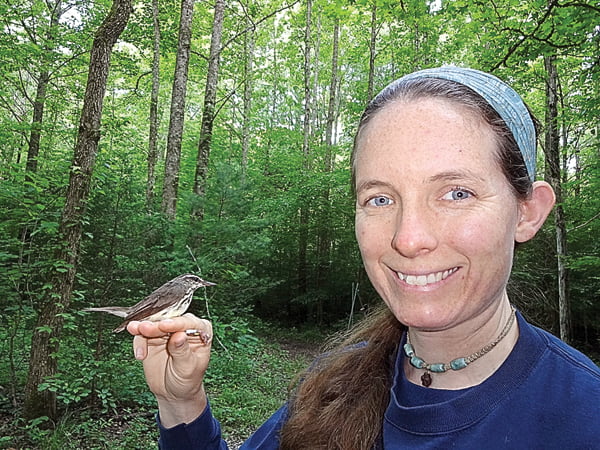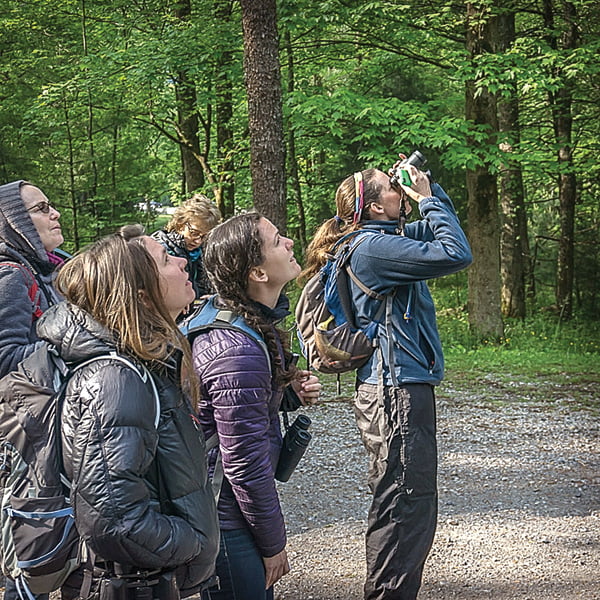
Ornithologist Tiffany Beachy charms a Louisiana Waterthrush during one of her many forays into the wild to study different species of birds.
Laura Dean Bennett
Staff Writer
There’s an expression that goes, “Do what you love and you’ll never work a day in your life.”
Ornithologist Tiffany Beachy is one of those lucky people who is doing what she loves. But that’s not to say that she doesn’t put in some long days.
It’s not unusual for Beachy to be on the road 12 to 14 hours a day – leaving before daylight and coming home long after dark.
What keeps this ornithologist on the go so much?
“I cover twenty-four counties in the eastern portion of the state,” Beachy explained.
“Of course, Pocahontas County is my favorite. I’m blessed to call it my home.
“I love the remote and rural character of Pocahontas County, and how everybody seems to know everybody.
“I love how I’ve only been here for just over a year, and I already feel like an accepted and valued member of the community.
“And the cool climate and low humidity is a plus, as well!” she added with a smile.
As the Golden-Winged warbler Partner Biologist for the USDA Natural Resources Conservation Service and the WV Division of Natural Resources, Beachy works with interested landowners to develop habitat conservation plans for their property.
These plans are intended to create or enhance young forest habitat to benefit not just Golden-winged Warblers (a relatively uncommon species in West Virginia), but other animals, including Ruffed Grouse, American Woodcock, Wild Turkey, White-tailed Deer, Black Bear and Cotton-tailed Rabbits.
The program offers financial assistance programs that reimburse landowners for implementing conservation practices such as rotational mowing, tree/shrub planting, wildflower planting and timber harvesting.
She has a Bachelor of Science degree in Wildlife Science, with a minor in Biology from Virginia Tech, and a Master’s in Wildlife Science from the University of Tennessee, Knoxville.
“I studied Cerulean Warblers in grad school, and a friend in grad school studied Golden-winged Warblers, so a position focused on managing forests to create habitat for these two declining species was the perfect fit for me,” she said.
“I’ve always been intrigued by God’s creation.
“I basically lived outside growing up – building forts and making tiny homes for little creatures.
“I knew I wanted to study something having to do with nature, but I wasn’t sure what.”
When she was in high school and beginning to consider colleges, Beachy discovered that there was such a thing as majoring in wildlife science.
“I remember thinking, ‘Well, that’s it!” she said. “They made a major just for me!”

Tiffany Beachy, at the front of the crowd, uses binoculars to locate birds during her time in Argentina. Beachy has traveled the world to study and teach and has worked as a volunteer biologist, monitoring multiple species of birds.
Beachy decided to specialize in birds while at Virginia Tech.
Beachy grew up in Roanoke, Virginia, the fourth of five children.
“I’ve always been intrigued by bird behavior, and I associate certain memories from my childhood with bird sound,” she explained.
Learning Spanish came easily to her and so did learning to identify birds by their bird sounds and songs.
“That was always so much easier for me than learning to identify birds by sight,” she admitted.
“When I began to learn more about birds in my Ornithology class in college, my whole way of observing the world changed.
“Suddenly there was this whole new dimension of sound around me.
“Once I began the journey of learning bird sound, I felt like I became a more observant person in general.
“Now I can’t turn it off. I am perpetually noticing the bird sounds and other noises around me.
“No two days are alike with my current position, so it stays interesting and challenging. I have the flexibility to stay inside and work on contracts when the weather is crummy, and to conduct site visits when it’s beautiful.
“I think I would find it difficult to be fully content in a job that didn’t involve any kind of work in the field. I enjoy connecting with the people who desire to be good stewards of the land.
“One of my favorite parts of my job here is the privilege of meeting so many dedicated landowners and exploring their amazing properties.
“Birds are a good indicator of environmental health,” she explained. “If a bird population is declining, it indicates a bigger systemic problem in the environment.
“It’s important to work together to conserve and manage bird habitat across their entire global range, from the breeding grounds, to the stopover sites they use during migration, to their wintering grounds in the tropics,” she explained.
“Many birds have experienced significant population declines over the past fifty years or so.
“In the Western hemisphere, much of the decline is due to habitat loss on all portions of migratory birds’ annual range, from Canada to the tip of South America.
“Habitat loss is often due to coastal development, urban and suburban expansion, industrialized agriculture, use of pesticides and herbicides and energy development.
“And domestic cats cause population decline of native songbirds, and millions of birds strike windows, towers, skyscrapers and other structures every year during migration.”
Beachy’s most life-changing bird research experience came about when she was working as a volunteer biologist on Espanola Island in the Galapagos Islands of Ecuador from 2003 to 2004.
“I was hired as a biological field technician for a Wake Forest University research project,” Beachy said. “It was a rugged, some might even say, difficult work environment.
“I lived in a tent on an uninhabited island for seven months – but it was paradise.
”We were near an extinct volcano, on the farthest southern island of the Galapagos. I loved being able to stand on the southern facing beach, look out to sea and think that the next land mass would be Antarctica.
“I monitored Waved Albatrosses and Nazca Boobies, snorkeled with sea lions and sharks on one of the most beautiful reefs in the world and explored the rugged coastline.
“I spent a lot of time weighing and measuring Waved Albatross chicks.
“There were four of us. We each had a tent and there was a common tent, which we used as our kitchen.”
This was the Tropics, so the weather was hot and there was no fresh water anywhere on the island.
Shipments of food – mostly canned or dried – and water came by boat every few months.
“We’d put together ‘shopping lists.’” Beachy explained with a smile. “We’d get a little fresh produce – usually eggs, potatoes, onions, garlic, carrots, cheese.
“And the delivery would always include 200 cans of tuna,” she laughed.
“We couldn’t have anything with seeds, so as not to accidently seed any plants there on the island.
“The wildlife had no innate fear of humans. We often shared our kitchen with a ‘teenage’ sea lion or albatross.
“It was a magical place.”
Anyone interested in managing habitat through the Golden-winged Warbler Working Lands for Wildlife program, or learning more about birds in West Virginia or Pocahontas County, may contact Tiffany Beachy at tiffany.beachy@usda.gov or 304-799-4317 ext. 3.
Ways to benefit birds and other wildlife
•Have a bird feeder? Great! Be sure to keep it clean to prevent spread of disease, and bring it inside when bears are most active (usually in the spring).
•Plant native trees/ shrubs/wildflowers.
•Provide a water source like a bird bath. Birds like to take baths every day!
• Don’t burn all your brush piles. Leave some on the edges of the woods or in the middle of fields. All kinds of critters love a brush pile.
• Think ‘The messier, the better!’ Let ‘waste’ spaces just be brushy! Here’s your excuse not to clean it up!
• Have a lot of grass to mow? Just stop mowing! Let some areas of your property grow up into beautiful meadows of wildflowers, blackberries, and other native species. Mow or bush-hog the area once every three to four years to keep it from reverting to forest.
• Keep cats indoors.



